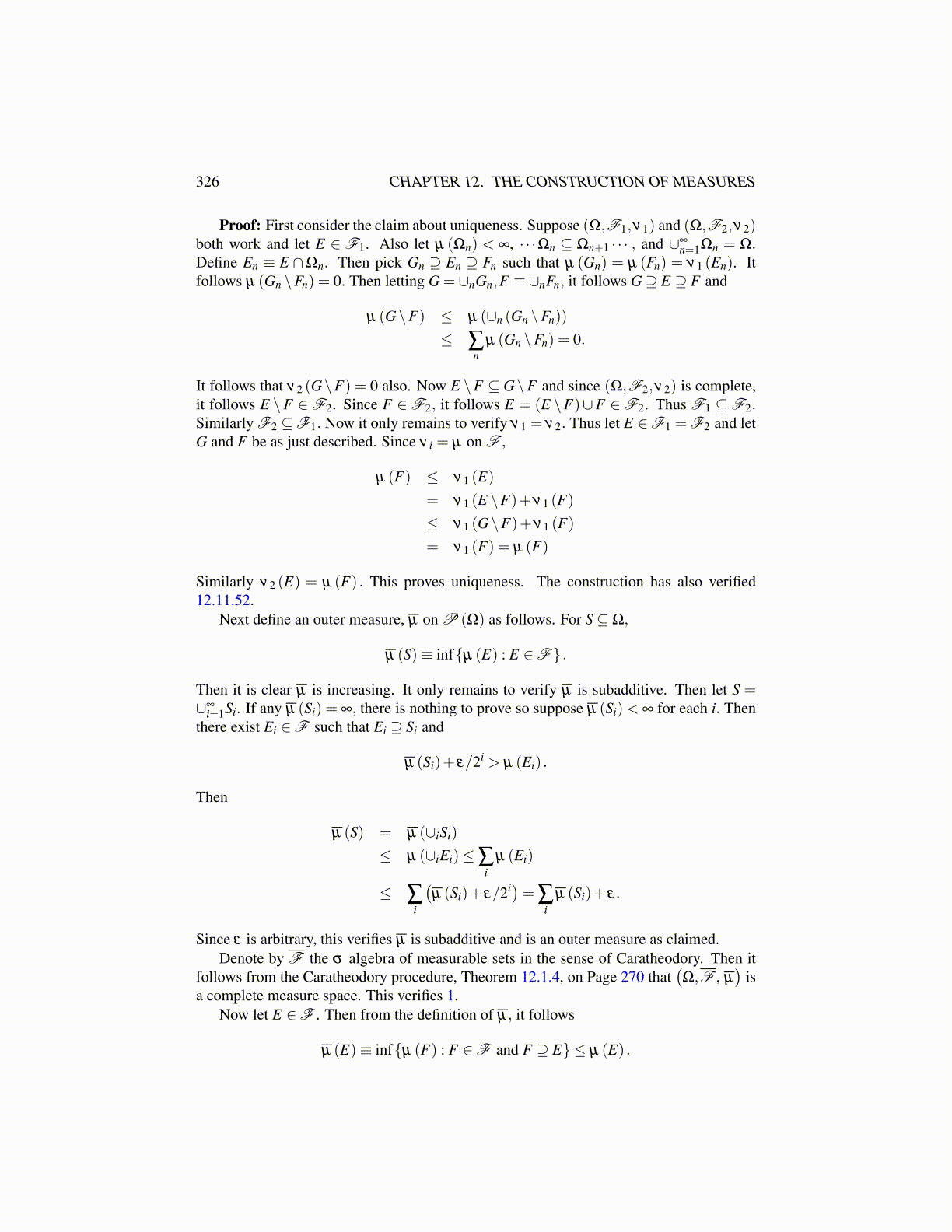
326 CHAPTER 12. THE CONSTRUCTION OF MEASURES
Proof: First consider the claim about uniqueness. Suppose (Ω,F1,ν1) and (Ω,F2,ν2)both work and let E ∈ F1. Also let µ (Ωn) < ∞, · · ·Ωn ⊆ Ωn+1 · · · , and ∪∞
n=1Ωn = Ω.Define En ≡ E ∩Ωn. Then pick Gn ⊇ En ⊇ Fn such that µ (Gn) = µ (Fn) = ν1 (En). Itfollows µ (Gn \Fn) = 0. Then letting G = ∪nGn,F ≡ ∪nFn, it follows G⊇ E ⊇ F and
µ (G\F) ≤ µ (∪n (Gn \Fn))
≤ ∑n
µ (Gn \Fn) = 0.
It follows that ν2 (G\F) = 0 also. Now E \F ⊆ G\F and since (Ω,F2,ν2) is complete,it follows E \F ∈F2. Since F ∈F2, it follows E = (E \F)∪F ∈F2. Thus F1 ⊆F2.Similarly F2 ⊆F1. Now it only remains to verify ν1 = ν2. Thus let E ∈F1 = F2 and letG and F be as just described. Since ν i = µ on F ,
µ (F) ≤ ν1 (E)
= ν1 (E \F)+ν1 (F)
≤ ν1 (G\F)+ν1 (F)
= ν1 (F) = µ (F)
Similarly ν2 (E) = µ (F) . This proves uniqueness. The construction has also verified12.11.52.
Next define an outer measure, µ on P (Ω) as follows. For S⊆Ω,
µ (S)≡ inf{µ (E) : E ∈F} .
Then it is clear µ is increasing. It only remains to verify µ is subadditive. Then let S =∪∞
i=1Si. If any µ (Si) = ∞, there is nothing to prove so suppose µ (Si)< ∞ for each i. Thenthere exist Ei ∈F such that Ei ⊇ Si and
µ (Si)+ ε/2i > µ (Ei) .
Then
µ (S) = µ (∪iSi)
≤ µ (∪iEi)≤∑i
µ (Ei)
≤ ∑i
(µ (Si)+ ε/2i)= ∑
iµ (Si)+ ε.
Since ε is arbitrary, this verifies µ is subadditive and is an outer measure as claimed.Denote by F the σ algebra of measurable sets in the sense of Caratheodory. Then it
follows from the Caratheodory procedure, Theorem 12.1.4, on Page 270 that(Ω,F , µ
)is
a complete measure space. This verifies 1.Now let E ∈F . Then from the definition of µ, it follows
µ (E)≡ inf{µ (F) : F ∈F and F ⊇ E} ≤ µ (E) .